YAMAHA MT-25 2016 Workshop Manual
Manufacturer: YAMAHA, Model Year: 2016, Model line: MT-25, Model: YAMAHA MT-25 2016Pages: 96, PDF Size: 5.16 MB
Page 51 of 96
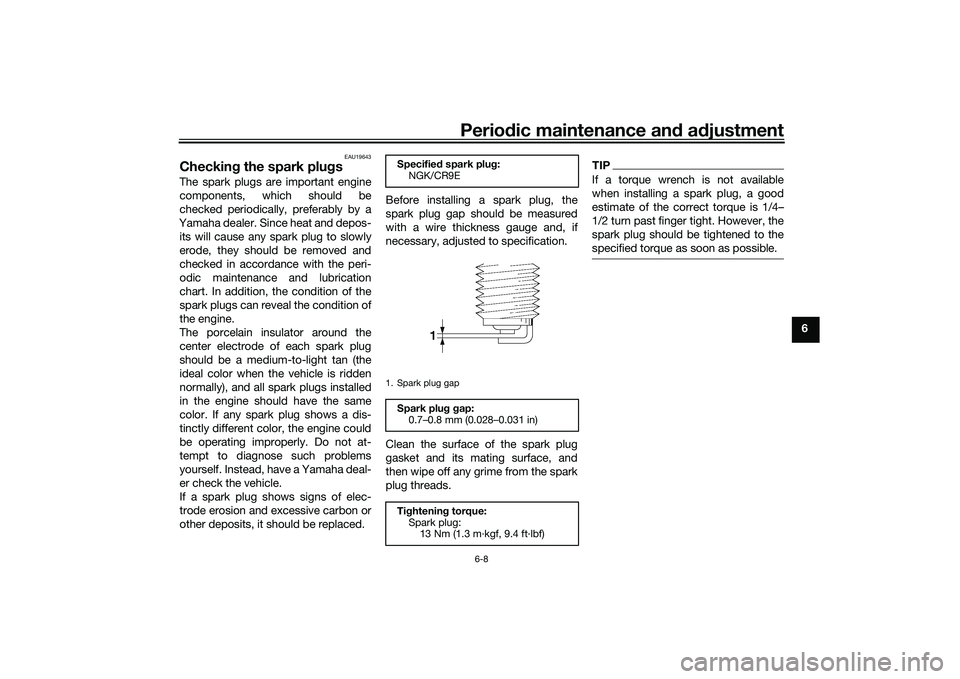
Periodic maintenance and adjustment
6-8
6
EAU19643
Checking the spark plugsThe spark plugs are important engine
components, which should be
checked periodically, preferably by a
Yamaha dealer. Since heat and depos-
its will cause any spark plug to slowly
erode, they should be removed and
checked in accordance with the peri-
odic maintenance and lubrication
chart. In addition, the condition of the
spark plugs can reveal the condition of
the engine.
The porcelain insulator around the
center electrode of each spark plug
should be a medium-to-light tan (the
ideal color when the vehicle is ridden
normally), and all spark plugs installed
in the engine should have the same
color. If any spark plug shows a dis-
tinctly different color, the engine could
be operating improperly. Do not at-
tempt to diagnose such problems
yourself. Instead, have a Yamaha deal-
er check the vehicle.
If a spark plug shows signs of elec-
trode erosion and excessive carbon or
other deposits, it should be replaced.Before installing a spark plug, the
spark plug gap should be measured
with a wire thickness gauge and, if
necessary, adjusted to specification.
Clean the surface of the spark plug
gasket and its mating surface, and
then wipe off any grime from the spark
plug threads.
TIPIf a torque wrench is not available
when installing a spark plug, a good
estimate of the correct torque is 1/4…
1/2 turn past finger tight. However, the
spark plug should be tightened to the
specified torque as soon as possible.
Specified spark plug:
NGK/CR9E
1. Spark plug gap
Spark plug gap:
0.7–0.8 mm (0.028–0.031 in)
Tightening torque:
Spark plug:
13 Nm (1.3 m·kgf, 9.4 ft·lbf)
UB04E0E0.book Page 8 Wednesday, September 2, 2015 3:51 PM
Page 52 of 96
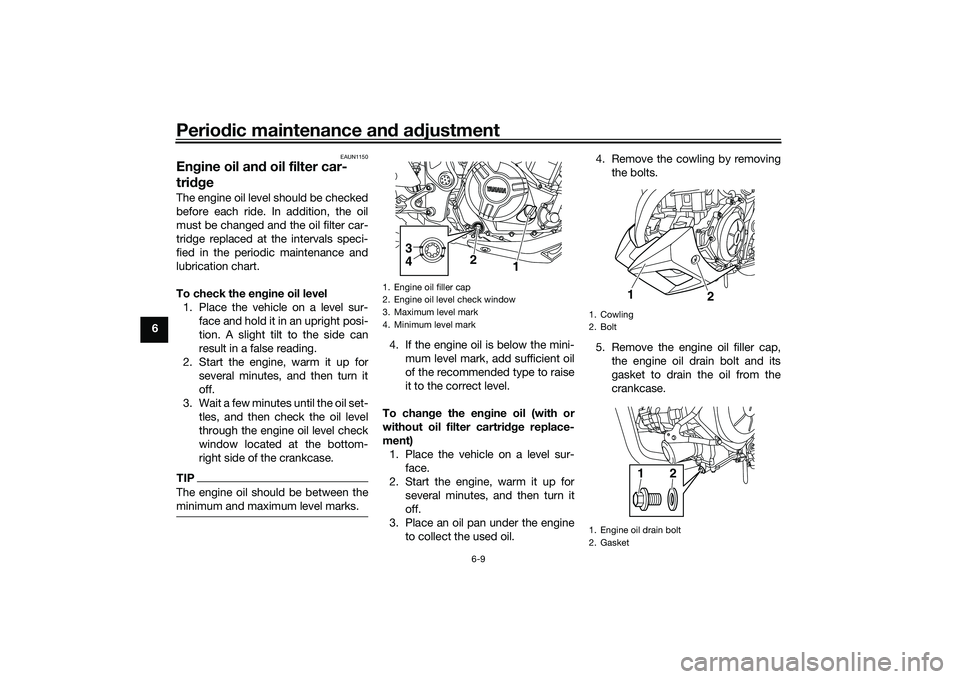
Periodic maintenance and adjustment
6-9
6
EAUN1150
Engine oil and oil filter car-
tridgeThe engine oil level should be checked
before each ride. In addition, the oil
must be changed and the oil filter car-
tridge replaced at the intervals speci-
fied in the periodic maintenance and
lubrication chart.
To check the engine oil level
1. Place the vehicle on a level sur-
face and hold it in an upright posi-
tion. A slight tilt to the side can
result in a false reading.
2. Start the engine, warm it up for
several minutes, and then turn it
off.
3. Wait a few minutes until the oil set-
tles, and then check the oil level
through the engine oil level check
window located at the bottom-
right side of the crankcase.TIPThe engine oil should be between the
minimum and maximum level marks.
4. If the engine oil is below the mini-
mum level mark, add sufficient oil
of the recommended type to raise
it to the correct level.
To change the engine oil (with or
without oil filter cartridge replace-
ment)
1. Place the vehicle on a level sur-
face.
2. Start the engine, warm it up for
several minutes, and then turn it
off.
3. Place an oil pan under the engine
to collect the used oil.4. Remove the cowling by removing
the bolts.
5. Remove the engine oil filler cap,
the engine oil drain bolt and its
gasket to drain the oil from the
crankcase.1. Engine oil filler cap
2. Engine oil level check window
3. Maximum level mark
4. Minimum level mark
3
4
1 2
1. Cowling
2. Bolt
1. Engine oil drain bolt
2. Gasket
1
2
12
UB04E0E0.book Page 9 Wednesday, September 2, 2015 3:51 PM
Page 53 of 96
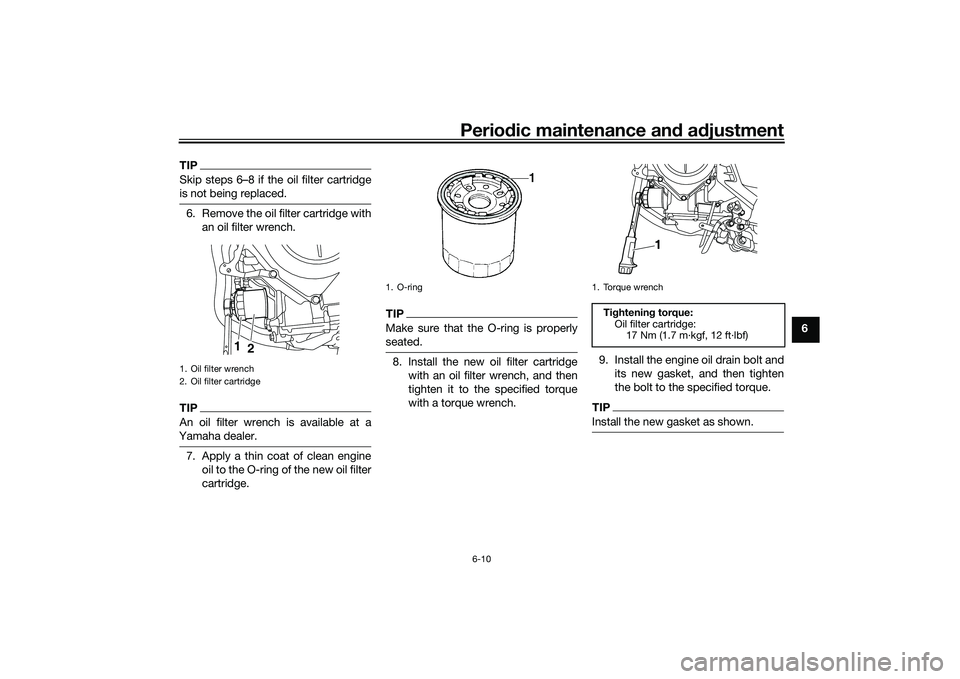
Periodic maintenance and adjustment
6-10
6
TIPSkip steps 6–8 if the oil filter cartridge
is not being replaced.6. Remove the oil filter cartridge with
an oil filter wrench.TIPAn oil filter wrench is available at a
Yamaha dealer.7. Apply a thin coat of clean engine
oil to the O-ring of the new oil filter
cartridge.
TIPMake sure that the O-ring is properly
seated.8. Install the new oil filter cartridge
with an oil filter wrench, and then
tighten it to the specified torque
with a torque wrench.9. Install the engine oil drain bolt and
its new gasket, and then tighten
the bolt to the specified torque.
TIPInstall the new gasket as shown.
1. Oil filter wrench
2. Oil filter cartridge
1
2
1. O-ring
1. Torque wrench
Tightening torque:
Oil filter cartridge:
17 Nm (1.7 m·kgf, 12 ft·lbf)
1
UB04E0E0.book Page 10 Wednesday, September 2, 2015 3:51 PM
Page 54 of 96
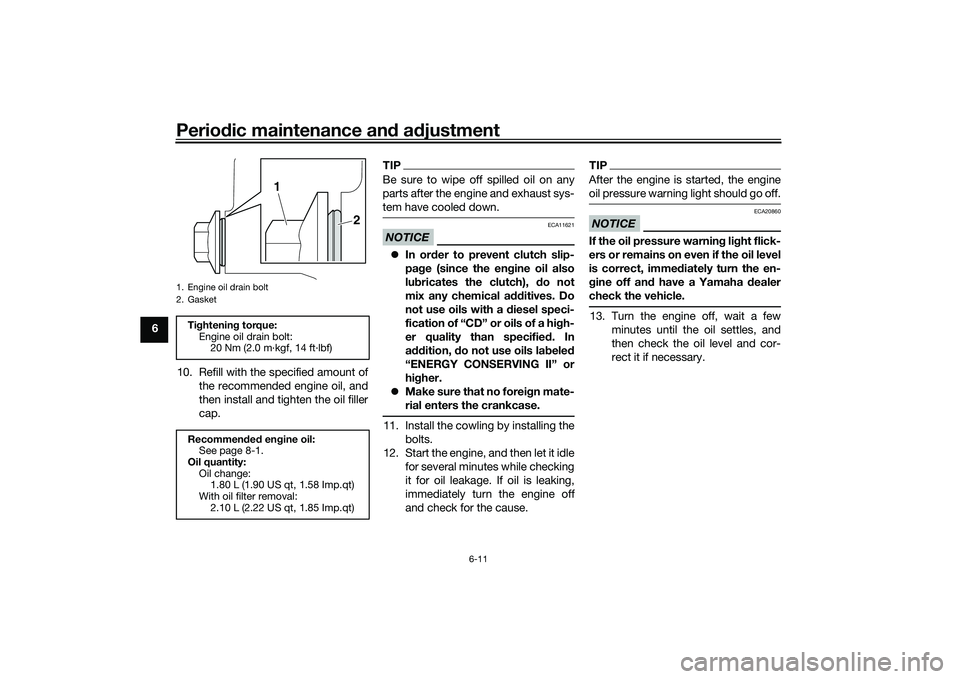
Periodic maintenance and adjustment
6-11
6
10. Refill with the specified amount of
the recommended engine oil, and
then install and tighten the oil filler
cap.
TIPBe sure to wipe off spilled oil on any
parts after the engine and exhaust sys-
tem have cooled down.NOTICE
ECA11621
In order to prevent clutch slip-
page (since the engine oil also
lubricates the clutch), do not
mix any chemical additives. Do
not use oils with a diesel speci-
fication of “CD” or oils of a high-
er quality than specified. In
addition, do not use oils labeled
“ENERGY CONSERVING II” or
higher.
Make sure that no foreign mate-
rial enters the crankcase.11. Install the cowling by installing the
bolts.
12. Start the engine, and then let it idle
for several minutes while checking
it for oil leakage. If oil is leaking,
immediately turn the engine off
and check for the cause.
TIPAfter the engine is started, the engine
oil pressure warning light should go off.NOTICE
ECA20860
If the oil pressure warning light flick-
ers or remains on even if the oil level
is correct, immediately turn the en-
gine off and have a Yamaha dealer
check the vehicle.13. Turn the engine off, wait a few
minutes until the oil settles, and
then check the oil level and cor-
rect it if necessary.
1. Engine oil drain bolt
2. GasketTightening torque:
Engine oil drain bolt:
20 Nm (2.0 m·kgf, 14 ft·lbf)
Recommended engine oil:
See page 8-1.
Oil quantity:
Oil change:
1.80 L (1.90 US qt, 1.58 Imp.qt)
With oil filter removal:
2.10 L (2.22 US qt, 1.85 Imp.qt)
2
1
UB04E0E0.book Page 11 Wednesday, September 2, 2015 3:51 PM
Page 55 of 96
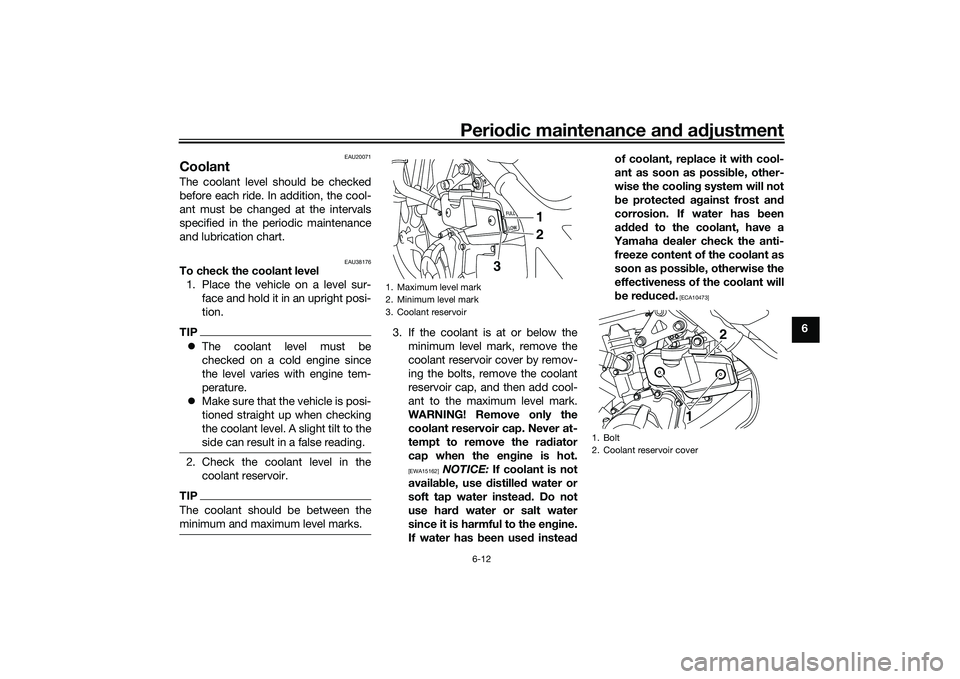
Periodic maintenance and adjustment
6-12
6
EAU20071
CoolantThe coolant level should be checked
before each ride. In addition, the cool-
ant must be changed at the intervals
specified in the periodic maintenance
and lubrication chart.
EAU38176
To check the coolant level
1. Place the vehicle on a level sur-
face and hold it in an upright posi-
tion.TIPThe coolant level must be
checked on a cold engine since
the level varies with engine tem-
perature.
Make sure that the vehicle is posi-
tioned straight up when checking
the coolant level. A slight tilt to the
side can result in a false reading.2. Check the coolant level in the
coolant reservoir.TIPThe coolant should be between the
minimum and maximum level marks.
3. If the coolant is at or below the
minimum level mark, remove the
coolant reservoir cover by remov-
ing the bolts, remove the coolant
reservoir cap, and then add cool-
ant to the maximum level mark.
WARNING! Remove only the
coolant reservoir cap. Never at-
tempt to remove the radiator
cap when the engine is hot.
[EWA15162]
NOTICE: If coolant is not
available, use distilled water or
soft tap water instead. Do not
use hard water or salt water
since it is harmful to the engine.
If water has been used insteadof coolant, replace it with cool-
ant as soon as possible, other-
wise the cooling system will not
be protected against frost and
corrosion. If water has been
added to the coolant, have a
Yamaha dealer check the anti-
freeze content of the coolant as
soon as possible, otherwise the
effectiveness of the coolant will
be reduced.
[ECA10473]
1. Maximum level mark
2. Minimum level mark
3. Coolant reservoir
1
2
3
1. Bolt
2. Coolant reservoir cover
2
1
UB04E0E0.book Page 12 Wednesday, September 2, 2015 3:51 PM
Page 56 of 96
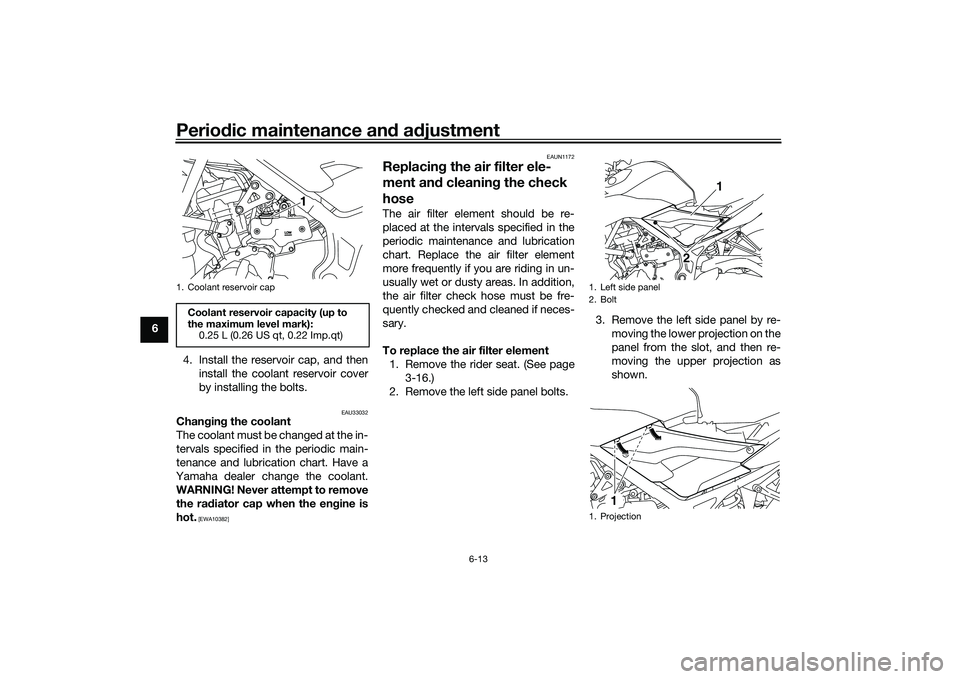
Periodic maintenance and adjustment
6-13
6
4. Install the reservoir cap, and then
install the coolant reservoir cover
by installing the bolts.
EAU33032
Changing the coolant
The coolant must be changed at the in-
tervals specified in the periodic main-
tenance and lubrication chart. Have a
Yamaha dealer change the coolant.
WARNING! Never attempt to remove
the radiator cap when the engine is
hot.
[EWA10382]EAUN1172
Replacing the air filter ele-
ment and cleaning the check
hoseThe air filter element should be re-
placed at the intervals specified in the
periodic maintenance and lubrication
chart. Replace the air filter element
more frequently if you are riding in un-
usually wet or dusty areas. In addition,
the air filter check hose must be fre-
quently checked and cleaned if neces-
sary.
To replace the air filter element
1. Remove the rider seat. (See page
3-16.)
2. Remove the left side panel bolts.3. Remove the left side panel by re-
moving the lower projection on the
panel from the slot, and then re-
moving the upper projection as
shown.
1. Coolant reservoir capCoolant reservoir capacity (up to
the maximum level mark):
0.25 L (0.26 US qt, 0.22 Imp.qt)
1
1. Left side panel
2. Bolt
1. Projection
1
2
1
UB04E0E0.book Page 13 Wednesday, September 2, 2015 3:51 PM
Page 57 of 96
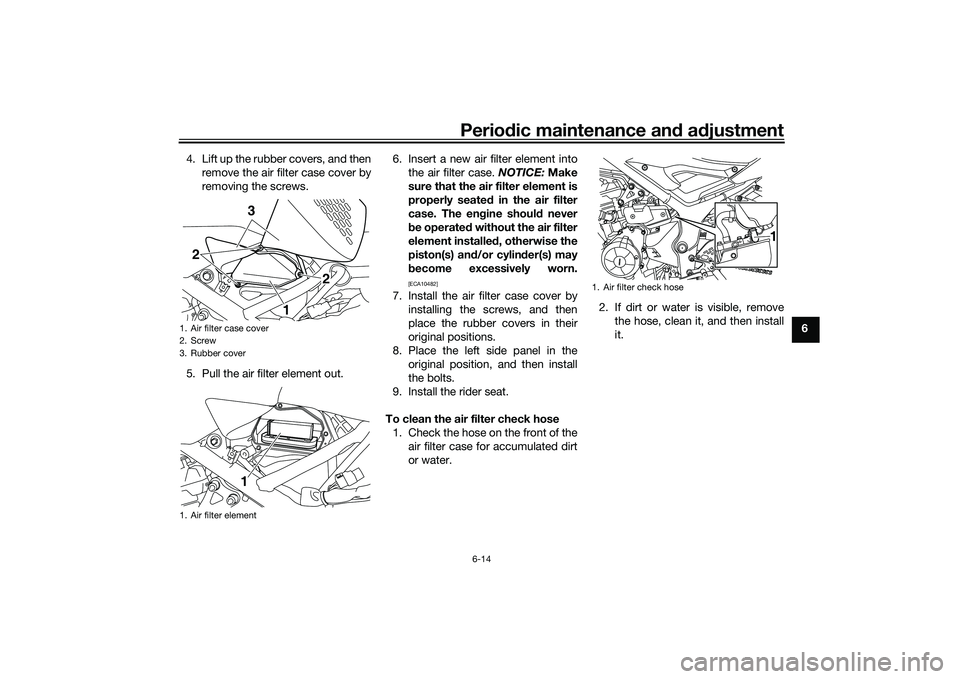
Periodic maintenance and adjustment
6-14
6 4. Lift up the rubber covers, and then
remove the air filter case cover by
removing the screws.
5. Pull the air filter element out.6. Insert a new air filter element into
the air filter case. NOTICE: Make
sure that the air filter element is
properly seated in the air filter
case. The engine should never
be operated without the air filter
element installed, otherwise the
piston(s) and/or cylinder(s) may
become excessively worn.
[ECA10482]
7. Install the air filter case cover by
installing the screws, and then
place the rubber covers in their
original positions.
8. Place the left side panel in the
original position, and then install
the bolts.
9. Install the rider seat.
To clean the air filter check hose
1. Check the hose on the front of the
air filter case for accumulated dirt
or water.2. If dirt or water is visible, remove
the hose, clean it, and then install
it.
1. Air filter case cover
2. Screw
3. Rubber cover
1. Air filter element
12
23
1
1. Air filter check hose
1
UB04E0E0.book Page 14 Wednesday, September 2, 2015 3:51 PM
Page 58 of 96
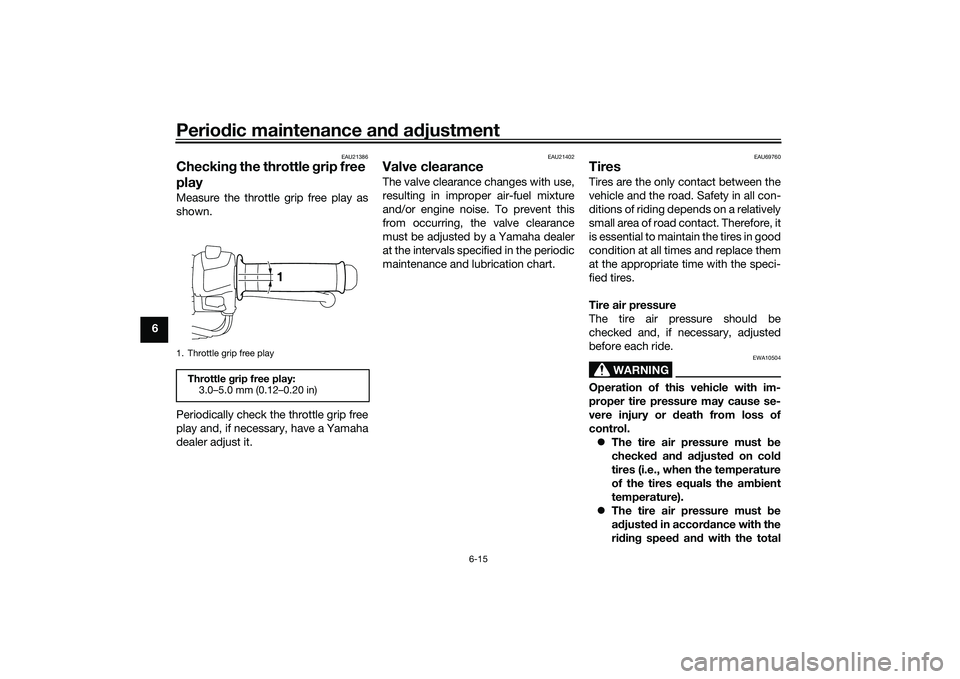
Periodic maintenance and adjustment
6-15
6
EAU21386
Checking the throttle grip free
playMeasure the throttle grip free play as
shown.
Periodically check the throttle grip free
play and, if necessary, have a Yamaha
dealer adjust it.
EAU21402
Valve clearanceThe valve clearance changes with use,
resulting in improper air-fuel mixture
and/or engine noise. To prevent this
from occurring, the valve clearance
must be adjusted by a Yamaha dealer
at the intervals specified in the periodic
maintenance and lubrication chart.
EAU69760
TiresTires are the only contact between the
vehicle and the road. Safety in all con-
ditions of riding depends on a relatively
small area of road contact. Therefore, it
is essential to maintain the tires in good
condition at all times and replace them
at the appropriate time with the speci-
fied tires.
Tire air pressure
The tire air pressure should be
checked and, if necessary, adjusted
before each ride.
WARNING
EWA10504
Operation of this vehicle with im-
proper tire pressure may cause se-
vere injury or death from loss of
control.
The tire air pressure must be
checked and adjusted on cold
tires (i.e., when the temperature
of the tires equals the ambient
temperature).
The tire air pressure must be
adjusted in accordance with the
riding speed and with the total
1. Throttle grip free playThrottle grip free play:
3.0–5.0 mm (0.12–0.20 in)
1
UB04E0E0.book Page 15 Wednesday, September 2, 2015 3:51 PM
Page 59 of 96
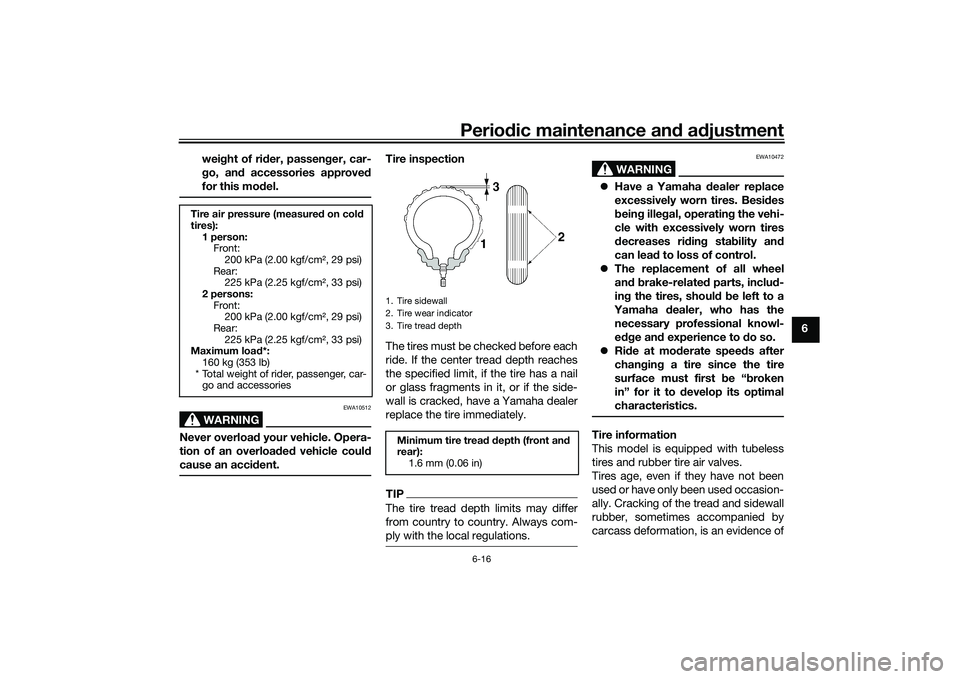
Periodic maintenance and adjustment
6-16
6 weight of rider, passenger, car-
go, and accessories approved
for this model.
WARNING
EWA10512
Never overload your vehicle. Opera-
tion of an overloaded vehicle could
cause an accident.
Tire inspection
The tires must be checked before each
ride. If the center tread depth reaches
the specified limit, if the tire has a nail
or glass fragments in it, or if the side-
wall is cracked, have a Yamaha dealer
replace the tire immediately.TIPThe tire tread depth limits may differ
from country to country. Always com-
ply with the local regulations.
WARNING
EWA10472
Have a Yamaha dealer replace
excessively worn tires. Besides
being illegal, operating the vehi-
cle with excessively worn tires
decreases riding stability and
can lead to loss of control.
The replacement of all wheel
and brake-related parts, includ-
ing the tires, should be left to a
Yamaha dealer, who has the
necessary professional knowl-
edge and experience to do so.
Ride at moderate speeds after
changing a tire since the tire
surface must first be “broken
in” for it to develop its optimal
characteristics.Tire information
This model is equipped with tubeless
tires and rubber tire air valves.
Tires age, even if they have not been
used or have only been used occasion-
ally. Cracking of the tread and sidewall
rubber, sometimes accompanied by
carcass deformation, is an evidence of
Tire air pressure (measured on cold
tires):
1 person:
Front:
200 kPa (2.00 kgf/cm2, 29 psi)
Rear:
225 kPa (2.25 kgf/cm2, 33 psi)
2 persons:
Front:
200 kPa (2.00 kgf/cm2, 29 psi)
Rear:
225 kPa (2.25 kgf/cm2, 33 psi)
Maximum load*:
160 kg (353 lb)
* Total weight of rider, passenger, car-
go and accessories
1. Tire sidewall
2. Tire wear indicator
3. Tire tread depth
Minimum tire tread depth (front and
rear):
1.6 mm (0.06 in)
UB04E0E0.book Page 16 Wednesday, September 2, 2015 3:51 PM
Page 60 of 96
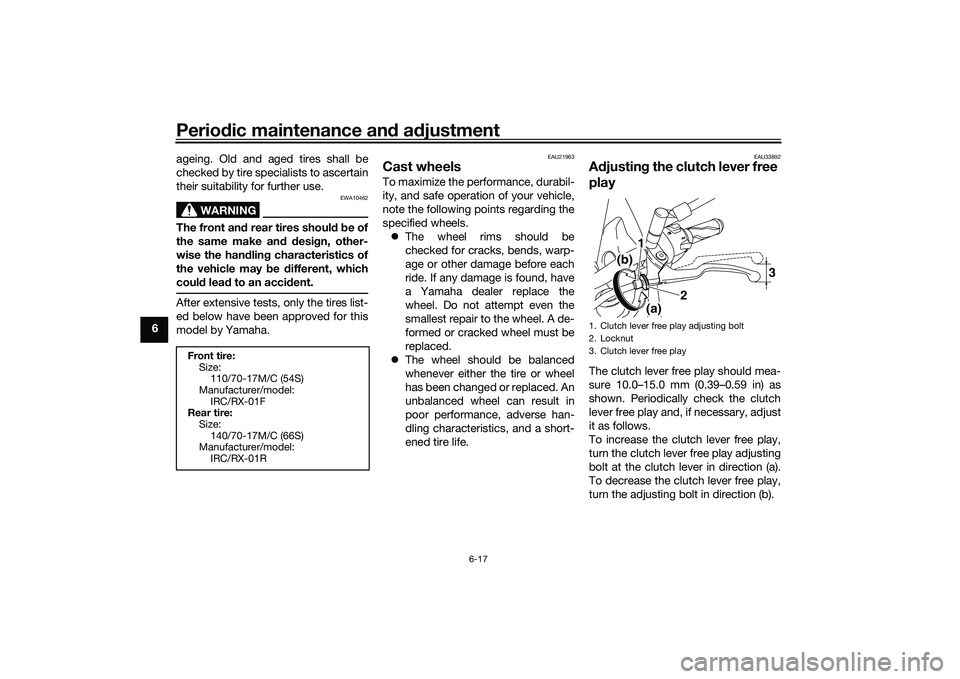
Periodic maintenance and adjustment
6-17
6ageing. Old and aged tires shall be
checked by tire specialists to ascertain
their suitability for further use.
WARNING
EWA10462
The front and rear tires should be of
the same make and design, other-
wise the handling characteristics of
the vehicle may be different, which
could lead to an accident.After extensive tests, only the tires list-
ed below have been approved for this
model by Yamaha.
EAU21963
Cast wheelsTo maximize the performance, durabil-
ity, and safe operation of your vehicle,
note the following points regarding the
specified wheels.
The wheel rims should be
checked for cracks, bends, warp-
age or other damage before each
ride. If any damage is found, have
a Yamaha dealer replace the
wheel. Do not attempt even the
smallest repair to the wheel. A de-
formed or cracked wheel must be
replaced.
The wheel should be balanced
whenever either the tire or wheel
has been changed or replaced. An
unbalanced wheel can result in
poor performance, adverse han-
dling characteristics, and a short-
ened tire life.
EAU33892
Adjusting the clutch lever free
playThe clutch lever free play should mea-
sure 10.0–15.0 mm (0.39–0.59 in) as
shown. Periodically check the clutch
lever free play and, if necessary, adjust
it as follows.
To increase the clutch lever free play,
turn the clutch lever free play adjusting
bolt at the clutch lever in direction (a).
To decrease the clutch lever free play,
turn the adjusting bolt in direction (b).
Front tire:
Size:
110/70-17M/C (54S)
Manufacturer/model:
IRC/RX-01F
Rear tire:
Size:
140/70-17M/C (66S)
Manufacturer/model:
IRC/RX-01R
1. Clutch lever free play adjusting bolt
2. Locknut
3. Clutch lever free play
3
(a) 1
2 (b)
UB04E0E0.book Page 17 Wednesday, September 2, 2015 3:51 PM